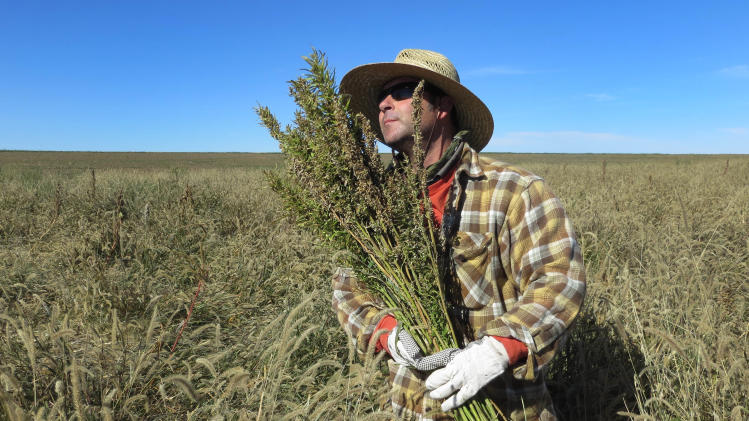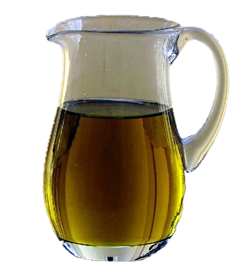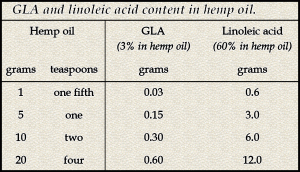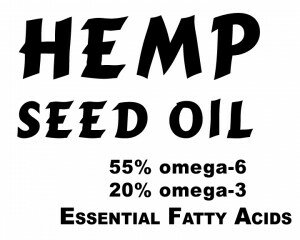BY: PETRA PLESS AND GERO LESON
LESON ENVIRONMENTAL CONSULTING JULY 1998
Why Hemp Oil?
Hemp oil, or hemp oil, is a tasty oil with a green or golden colour crushed from the seeds of the hemp plant (Cannabis sativa L.).
Traditionally used for food and body care, but almost forgotten, it is now making a strong comeback. It increasingly appears in the cold storage of health food markets as well as an ingredient in “natural” cosmetics.
Why? There are four main reasons:
•Hemp oil provides our body with a range of necessary nutrients and helps prevent a variety of common diseases. Particularly, its attractive fatty acid composition, i.e. its very high content of essential fatty acids, provides nutritional advantages over other vegetable oils.
•Carefully produced and stored hemp oil simply tastes good. Thus, instead of just being a food supplement, it can serve as a staple food in the modern kitchen.
•If used in cosmetics, it protects the skin and slows down its unavoidable aging process.
•Since hemp is usually grown in an eco-friendly manner, hemp oil is a truly natural product.
If used for cooking, cold pressed unrefined hemp oil lends its nutty flavour and healthy composition to a variety of foods. It is a delicious alternative wherever olive oil, walnut oil, or butter are used. Favourite hemp oil recipes include salad dressings, lightly stir fried or sautéed meats and vegetables, marinated vegetables and sauces. Or just try dipping bread into it.
Hemp oil has its limitations in cooking applications. Like other unrefined oils, hemp oil tends to smoke at relatively low temperatures. This indicates the formation of unhealthy oxidation and polymerization products and suggests that unrefined hemp oil should not be used for frying or deep-frying. This brochure takes a closer look at the nature, health benefits and various uses of hemp oil.
Some Oil Chemistry
A bit of knowledge on hemp oil’s composition will go a long way towards understanding its unique benefits. As with other vegetable oils, its main constituents are the so called fatty acids.
Despite the often confusing debate of “Fat: good or bad?” consumers have caught on to the idea that improper fat intake contributes to a host of – often fatal – illnesses. They’ve also heard that fats are “the more unsaturated the better”. The following sheds some, hopefully not too technical, light on the connection between fat composition and health.
Fatty Acids
Fats and oils have the same chemical structure but a different melting point: fats are solid at room temperature, oils are liquid. Chemically they are composed of a glycerol backbone with three fatty acids (FAs) attached. Each type of oil has a characteristic fatty acid composition (see Table below). Fatty acids are distinguished by their chain length, i.e. the number of carbon atoms, but most important is the distinction between saturated and unsaturated fatty acids.
Saturated fatty acids (SaFAs) are straight molecules. All carbon atoms are bonded the same way and with maximum strength. The parallel molecules stick easily to one another and fats high in SaFAs (e.g. animal lards, coconut fat) are solid a room temperature. The human body uses SaFAs primarily for energy storage. Until a few years ago, fats and oils with a high SaFA content had been preferred for foods because their saturated bonds are stable, resist oxidation and thus rancidity.
They can be used for frying, and are inexpensive. On the downside, it was discovered that the “sticky” SaFAs contribute strongly to the formation of clots and deposits in our blood vessels, to strokes and other common cardiovascular diseases. The recognition that “too much unsaturated fats kill too many people” has brought about a shift in food producers’ and consumers’ preference to oil containing more of the so-called
Unsaturated fatty acids (UFAs). They contain one (monounsaturated) or several (polyunsaturated) double bonds between adjacent carbon atoms. The resulting curved shape makes oils with a high UFA-content “slicker” and keeps them liquid down to lower temperatures. UFAs are the raw material for the construction of cell membranes and contribute to cell membrane fluidity. A diet low in UFAs forces the body to use SaFAs for the construction of cell membranes, resulting in cells with stiff, rigid membranes. UFAs also are needed as raw materials for many important messenger and regulator substances in our body (prostaglandins, hormones, neurotransmitters). There are many different UFAs produced in nature, primarily found in plant seeds but also in fish oil. Particularly important for the human diet are two of these UFAs, also referred to as;
Essential Fatty Acids
These two essential fatty acids (EFAs) are linoleic acid (LA) and alpha-linolenic acid (ALA). They are necessary for cell and body growth, maintenance of cell membranes, and as precursors to a variety of physiologically active regulators. They are called “essential” because our body cannot, as with other FAs, produce them ourselves. Instead, they must be present in our diet.
Linoleic acid is a double unsaturated fatty acid common in plants: Evening primrose oil contains up to 70% of its total fatty acid content as linoleic acid. Unrefined sun flower oil contains up to 65%, hemp oil up to 60%, soybean oil up to 55%, and flax oil up to 30% linoleic acid. The human body synthesizes another important fatty acid from linoleic acid: gamma-linolenic acid (see below).
Alpha-linolenic acid, a triple unsaturated fatty acid, is found in algae, crustaceans, and in fish oil. Only a few seeds of higher plants have substantial contents of this essential fatty acid: flax (up to 58%), hemp (up to 25%), canola and soybean (up to 12%).
In order to provide our body with sufficient, yet not too much EFAs, a nutritionally balanced diet should contain EFAs in a ratio of roughly 3:2 (linoleic acid: alpha-linolenic acid).
The distribution of essential fatty acids in hemp oil is close to this favourable ratio (2:1 to 3:1). Thus, if hemp oil is our only source of fatty acids, roughly two to four teaspoons per day suffice to meet our EFA needs. Flax oil, with its higher total EFA content has a much less favourable ratio of below 1:2.
i.e. contains very high proportions of ALA. Thus, it is suitable as a supplement in case of ALA deficiency, but not as everyday food oil.
Typical fatty acid composition of unrefined edible oils.
| |
Essential
Fatty Acid
Content
% of total oil
|
alpha-Linolenic
Acid *
C18:3w3essential
|
Linoleic
Acid
C18:2w6essential
|
Oleic
Acid
C18:1w9monounsaturated
|
Stearic
Acid
C18:0saturated
|
Palmitic
Acid
C16:0saturated
|
gamma-Linolenic Acid (GLA)poly-unsaturated
|
Hemp
|
80
|
15~25
|
50~70
|
10~16
|
2~3
|
6~9
|
1~4
|
———————-
In addition to alpha-linolenic acid, hemp oil contains typically 1-4% gamma-linolenic acid (GLA, C18:3w6) (from Erasmus 1994, Deferne&Pate 1996)

Gamma-Linolenic Acid (GLA)
In addition to the two EFAs, hemp oil is a source of yet another important polyunsaturated fatty acid, gamma-linolenic acid (GLA). In fact, it is the only edible oil with a relevant GLA content, typically 1-4%. Other GLA sources are evening primrose (6-14%) and borage (25-40%) oil. Because of their unattractive taste these oils are offered as dietary supplements, not as cooking oils.
As already mentioned, our diet usually contains sufficient linoleic acid, which our bodies convert enzymatically into GLA. Yet, in many people this conversion process is too slow for several reasons (high meat and fat diets, alcohol, genetic causes). This can result in decreased GLA levels and contribute to a number of common illnesses (see below). Supplementation of GLA with the diet can alleviate the resulting health problems.
Other Constituents
In addition to fatty acids, cold pressed hemp oil provides low to moderate quantities of other beneficial nutrients, for example: other rarely occurring polyunsaturated fatty acids, Tocopherols (Vitamin E), phytosterols and flavour compounds. Their amounts vary strongly with the hemp variety and the type of processing of the oil. The presence of these compounds in hemp oil also contributes to its reputation as a “holistic” food, i.e. one that provides a whole range of the nutrients that our body needs – in a balanced and tasty blend.
Health, Nutrition and Therapeutic Uses of Hemp Oil
The oils high in EFAs and GLA actually prevent, or even cure, a large number of illnesses has been shown in several clinical studies. The following lists a few of the successes.
Many “modern” health problems, including heart disease, obesity, skin diseases and certain cancers have been blamed on “too much of the wrong fats, not enough of the right ones” in our diet.
Health specialists now recommend that fat consumption be limited to no more than 30 percent of our total calorie intake. However, fats and oil are not only a source of energy, they also provide the necessary EFAs. Thus, if we eat fats, they should contain as much EFAs and other unsaturated fatty acids as possible…in the proper ratio. Their benefits have been proven in numerous clinical studies.
A variety of diseases can be successfully treated with GLA and linoleic acid, both well represented in hemp oil.
Neurodermitis
Patients with neurodermitis suffer from agonizing itching, especially at night. The skin feels very dry and the activity of perspiratory and sebaceous glands is low. Neurodermitis – as is psoriasis – is characterized by a high water loss through the skin. Deficiency in EFAs can be one of the main causes. Essential fatty acids have a strong influence on the barrier function of the skin, because they regulate water loss through the epidermis (outer layer of the skin).
Patients with neurodermitis show a deficiency of essential fatty acids which affects the whole body. It is assumed that low enzymatic activity leads to reduced transformation of linoleic acid to GLA and subsequently to prostaglandin deficiency. Hemp oil, due to its high content in both, linoleic and gamma-linolenic acid, thus can assist in the treatment of this disease. The daily oral dose found to improve skin condition over a twelve week period corresponds to 18 grams or about four teaspoons of hemp oil. Another study showed improved skin conditions through external application of an ointment containing gamma-linolenic acid.
Cardiovascular Diseases
Most of the cardiovascular diseases threatening the health of people around the world are caused by the formation of arterial plaque, i.e. the deposition of blood components on the interior walls of our blood vessels. This process may eventually block blood flow and cause arteriosclerosis and strokes.
LDL cholesterol, a sticky substance present in the blood, has been identified as one of the main contributors to arterial plaque formation. Among other factors, such as smoking and stress, the intake of the saturated fatty acids present in animal fat is known to contribute to a high LDL level in the blood. Reversely, dietary treatment of patients with daily doses of linoleic acid and GLA which correspond roughly to four teaspoons of hemp oil, has shown to rapidly decrease elevated blood levels of both, LDL cholesterol and total cholesterol. Thus, the replacement of oils and fats high in SaFA with hemp oil will help reduce the risk of arteriosclerosis and other cardiovascular diseases.
PMS
PMS, or premenstrual syndrome, can include varying intensities of painful muscular tension, swelling of the breast, tension and irritability as well as aggressiveness and depression.
Investigations indicate that women with PMS suffer from a fatty acid metabolism disorder, where the ability to convert linoleic acid into gamma-linolenic acid and subsequently into prostaglandins is impaired.
A daily dose of 1.37 grams linoleic acid and 156 milligrams GLA over a twelve-week period significantly improved the PMS related symptoms in clinical studies. This dose corresponds to one teaspoon of hemp oil a day.
Rheumatoid Arthritis
Some fatty acids, including gamma-linolenic acid, are indicated as effective anti-inflammatory and immune system stimulating factors. Daily oral administration of 1.2-1.4 grams of GLA (corresponding to eight teaspoons of hemp oil) over a period of twelve weeks significantly alleviated the symptoms of rheumatoid arthritis.
Other Diseases
Other studies suggest administration of EFAs and GLA as preventive measure and a treatment for multiple sclerosis, schizophrenic psychosis, and cancer.
Multiple sclerosis occurs more frequently in geographical regions where the diet includes high amounts of saturated fats. Dietary supplementation of unsaturated fatty acids may have a positive effect on the course of the disease.
In patients with schizophrenic psychosis disturbances are found in the fatty acid metabolism which might be treated through administration of essential fatty acids.
Cancer treatment may be assisted by administration of linoleic acid and GLA. Cancer tissue and cells have lower contents of GLA and other related metabolites compared to healthy tissue. Linoleic acid enhances die-off of cancer cells. Administration of this essential fatty acid might therefore prove to have positive effects.
Obviously, increasing the dietary intake of EFAs and GLA at the expense of SaFAs, is an effective way to prevent these and other diseases. Hemp oil used in the kitchen provides as much of the EFAs as necessary – in the right composition. Its delicious taste is the “icing on the cake”.
The following table shows the GLA and linoleic acid content in hemp oil in grams and teaspoons and allows you to determine desired dosages. As the GLA content in hemp oil may vary (refer to product label), so may the amount of oil required to achieve a certain dose.
Hemp Oil in Body Care Products
The increasing popularity of hemp oil in cosmetics is also largely due to its high EFA content. Facial creams, body lotions, soaps, lip balm, shampoo and conditioner, massage oil with hemp oil are just some of the available products.
As a natural ingredient in the formulation of cosmetics, hemp oil provides the following benefits:
- The emollient, lubricant, and moisturizing properties of EFAs are well established. Although true EFA deficiency in humans is a rare condition, cosmetic skin problems such as scaling or dry, cracking skin also respond cosmetics containing EFAs. Because of their mobility, EFAs and GLA, counteract the ongoing loss of the skin’s natural barrier substance between the cells of the epidermis, thus preventing excessive moisture loss, dry-out, and cracking of the skin.
- The slow-down with age in the metabolism of cells in the basal layer of the epidermis also reduces the amount of EFAs released into the epidermis. This age related decline in activity is a major contributor to the above mentioned detrimental effects to the skin, thus contributing to the formation of wrinkles and overall skin aging. Topical application of EFAs partially compensates for their decline in the skin and the obvious effects of aging.
Hemp oil provides an additional benefit over other seed oil containing EFAs and GLA. Even when grown conventionally, hemp farming does usually not involve the use of pesticides and herbicides.
Rather, it provides additional agricultural benefits, such as suppression of weeds and pests.
This compares favorably to evening primrose and borage, specialty cultures which are sensitive to pests and weeds and require, unless grown organically, the use of synthetic chemicals. Thus, the pesticide free production of hemp seeds renders their oil a “truly natural” alternative to other seed oils.
Oil Production and Quality
Many plant oils naturally contain unsaturated fatty acids. Unfortunately, a high content in polyunsaturated fatty acids, such as in hemp and flax oil, increases the tendency of an oil to become rancid, especially when exposed to oxygen, light, and elevated temperatures. Rancidity results from the breakdown of fatty acids causing formation of rancid tasting and unhealthy compounds, such as aldehydes.
Most edible oils on supermarket shelves have been treated by mechanical and chemical refining processes to increase their shelf-life, enhance clarity and remove other undesirable compounds. The latter may result from poor seed quality or from the extraction process. Commercial oil making may include any or all of the following steps: solvent extraction of oil from the ground seeds, de-gumming, alkali refining, bleaching deodorizing, hydrogenation, and others.
Margarines, shortenings, and shortening oils for example are hydrogenated – or hardened – which removes unsaturated fatty acids, including the essential fatty acids. During the refining processes aroma and flavour as well as valuable compounds, for example vitamin E, lecithin, and minerals are removed.
Trace amounts of solvents may be present, preservatives added, and some of these processes may even result in the formation of unhealthy by-products, for example trans-fatty acids from hydrogenation, or hardening, of oils. Manufacturers are not required to declare these processes on the label, so they don’t.
Until recently, almost all oils on supermarket shelves used to be solvent extracted and fully refined. Such commodity oils aren’t “poisonous”. In fact, they also reflect the trend towards oils with a higher content of unsaturated fatty acids, i.e. sunflower, canola. Yet, they are bland and are missing valuable ingredients and character.
No wonder cold pressed oils (olive, walnut, safflower, pumpkin) are increasingly gaining shelf space.
Mechanically cold-pressed (not solvent extracted), unrefined oils have the characteristic aroma and flavour of the seeds from which they were pressed. Hemp oil for example has a delicate, nutty flavour. Unrefined oils still contain most of the vitamins, other antioxidants and minerals present in the seeds.
These oils generally also have a high content of unsaturated fatty acids which increases their tendency to become rancid and thus reduces their shelf-life. To make the most of the natural and healthy ingredients of these oils, they should be consumed fresh.
Unrefined, cold-pressed oils – such as hemp oil – are routinely pressed and bottled in a nitrogen atmosphere and sold in tinted or dark bottles to protect them from light. After opening they should be stored in the refrigerator and consumed within six months.
The THC Issue
Health agencies and media routinely raise the question: do hemp seeds and oil contain too much tetrahydrocannabinol (THC), the psychoactive ingredient of marijuana? Even hemp oil from European or Chinese low-THC varieties of industrial hemp routinely contains traces of THC, though too low to cause any noticeable effects. Surveys typically find 5-20 ppm (mg/kg).
The Swiss government recently set a 50 ppm maximum limit for THC in food. This suggests that THC in hemp oil usually does not pose the risk of involuntary intoxication or other health risks. Health Canada has set a more conservative limit of 10 ppm which many imported oils may fail to meet.
However, there are several ways to further reduce the THC content of hemp oil and other foods from hemp seeds.
Hemp seeds themselves do not contain THC. Rather, it is present in the flowers and their sticky resins may leave traces of THC on the seeds.
It comes as no surprise that thorough cleaning of the seeds, or even de-hulling, and the use of varieties with a very low THC-content have proven effective in reducing THC levels in oil to less than 5 ppm. Hemp oil producers now increasingly turn to these methods.
To provide guidance to decision makers, the nova institute recently suggested THC limits for various food products. see e.g. at the website of the North American Industrial Hemp Council www.naihc.org They provide a wide margin of safety from psychoactive effects and can be met as long as seeds are properly cleaned and low-THC varieties are used.
Answers to Commonly Asked Questions
Is sale of hemp oil legal?
Yes. Hemp oil can be legally imported or pressed in Europe, and from imported, sterilized seeds in the USA and for external use only in Australia.
Does hemp oil make high?
No. The meat of hemp seed does not contain the drug tetrahydrocannabinol (THC), which is the psychoactive substance in marijuana. Minute amounts of THC may be transferred from the flowers surrounding the leaves into the oil during pressing.
However, these trace amounts are, if seeds from low-THC varieties are used and properly cleaned, too low to have any psychoactive effects.
Can hemp oil be used for frying or deep-frying?
Better not. Unrefined hemp oil – just like olive oil – should not be used for high temperature or deep-frying. At high temperatures, unhealthy oxidation and polymerization products are formed from the unsaturated fatty acids. Furthermore, at temperatures approaching 400 F, undesirable trans-fatty acids are gradually formed. Quick sautéing is acceptable, yet care must be taken to keep the oil from smoking.Flax oil also has a high content in unsaturated essential fatty acids.
What is the benefit of hemp oil?
The ratio of the essential fatty acids (three parts linoleic acid to one part alpha-linolenic acid) in hemp oil is favourable for the human body because it matches its nutritional requirements. Flax oil, despite its higher essential fatty acid content, has a less favourable ratio (1:5). Flax oil also does not contain gamma-linolenic acid, an unsaturated fatty acid, which is found abundantly in hemp oil.
To maintain maximum freshness refrigerate after opening and use within six months.
Further Reading
Paul Benhaim: Modern Introduction to Hemp 2004
Paul Benhaim: Healthy Eating Made Possible. Vision Paperbacks 2000
Udo Erasmus: Fats that heal, fats that kill. Alive Books, 1994.
Jean-Luc Deferne, David W. Pate: Hemp seed oil: A source of valuable essential fatty acids. Journal of the International Hemp Association, Volume 3, Number 1, Pages 1-7, 1996.
Helga Mˆlleken, Roland R. Theimer: Survey of minor fatty acids in Cannabis sativa L. fruits of various origins. Journal of the International Hemp Association, Volume 4, Number 1, Pages 13-17, 1997.
Yung-Sheng Huang, David E. Mills: g-linolenic acid: Metabolism and its role in nutrition and medicine.
AOCS Press, 1996.
Glossary:
EFA: essential fatty acid
UFA: unsaturated fatty acid
PuFA: polyunsaturated fatty acid
SaFA: saturated fatty acid
THC: tetrahydrocannabinol
______________________
















